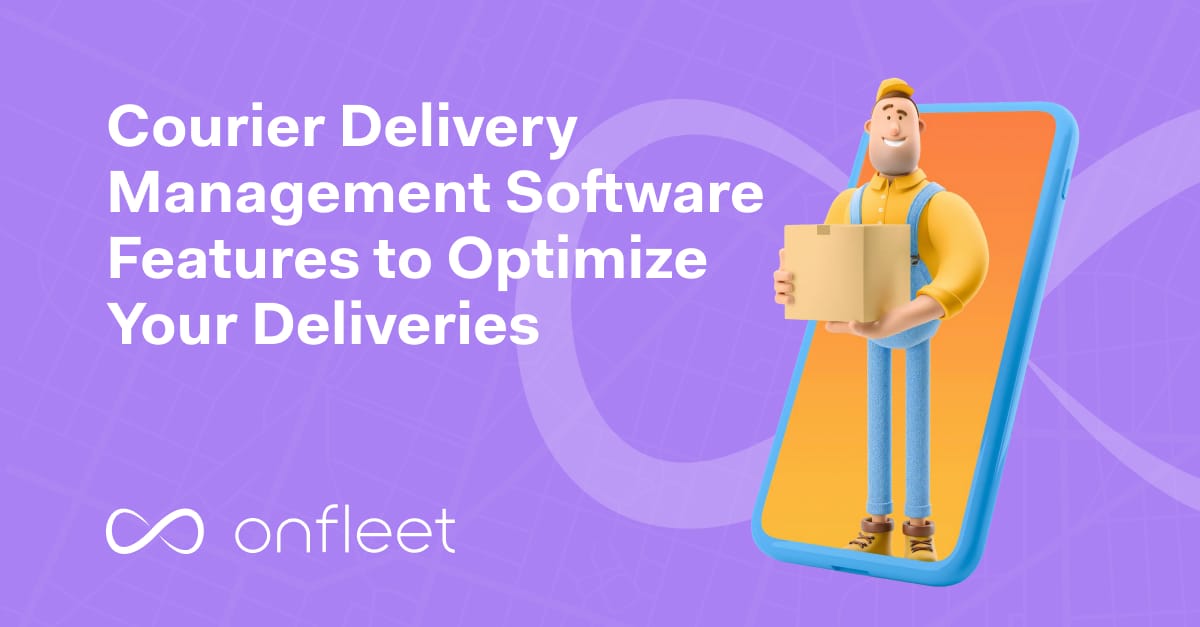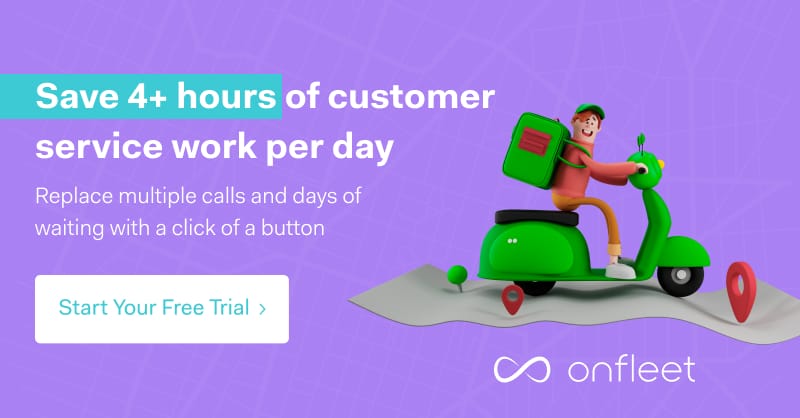For a courier delivery software to be effective, it needs to fit your business, you shouldn’t have to change to fit it.
We’ve identified 7 essential features that make all the difference to couriers. As a bonus, we also give you 3 tips to choose the right software for your courier business.

7 Key Features of Courier Delivery Software and Their Benefits:
1 - Delivery scheduling and dispatch
There are more effective ways to spend your day than spending hours manually scheduling drivers. You can focus on more strategic tasks by choosing software that does the scheduling and dispatching for you.
Onfleet’s courier delivery management software assigns deliveries to drivers automatically. It takes all deliveries and schedules the most efficient routes for their drivers so no driver is driving very long distances and doing very few deliveries. You should also have the power to filter deliveries based on location, driver, status, and more is also a powerful time-saver for teams.

2 - Route optimization
An effective route makes or breaks your profit and customer satisfaction. A huge advantage of courier delivery management software is that it plans and optimizes routes to be the most efficient possible.
The algorithms that courier management systems use optimize routes based on traffic, driver schedules, delivery windows, and number of deliveries.
At Onfleet, our route optimization is powerful enough to reduce fuel costs by 45% on average by creating the most efficient routes. Driver efficiency also increases by 30%, so you can deliver more in less time.
3 - Real-time Driver Tracking
How many times do you have to pick up the phone to answer a customer question about a late delivery or when they should expect a delivery? A lot of our customers had the same issue of wasting days everyone on customer service calls. Look for a tool that can track your drivers in real-time. That way dispatchers and customer support know what’s going on without needing to disturb your drivers by calling or texting them for updates.
This driver-tracking can also be available to customers via automatic status updates sent by text messages.

4 - Reporting and Analytics
Clear, accurate data gives you an edge over competitors. It helps you make informed decisions, adjust strategies based on what’s really working, and find effective solutions. Your data enables you to monitor performance, identify bottlenecks, and enhance service quality.
Examples of Key Metrics Tracked by Courier Delivery Software
Key metrics that you can track in delivery management software are:
- Average Time Per Delivery: Measure the time taken from when the order left the distribution center to it being delivered to the customer.
- Route Planning Efficiency: Assess the effectiveness of optimized delivery routes in terms of mileage and time.
- Driver Productivity: Evaluate the performance of individual drivers based on deliveries completed and adherence to schedules.
- On-Time Delivery Rate: Monitor the percentage of deliveries made within the specified time window.
- Completed Deliveries: This measures how many successful deliveries there were in a set period of time, even if they weren’t on time.
- First Attempted Delivery Rates: How many parcels were delivered on the first attempt.
- Deliveries Per Hour: Analyze how many deliveries a driver made per hour to measure their productivity.
- Customer Satisfaction: Gauge customer feedback and satisfaction levels through surveys or ratings.
5 - Customer Notifications
Keeping communication channels open with customers improves satisfaction. Being transparent about where their delivery is and when it will arrive also helps.
Find a tool that Onfleet sends automatic status updates to customers using text messages. Customers can track drivers live in a simple, branded, responsive web page. They can also send messages or call their driver, dispatcher, or call center with one click.
At the end of their delivery, customers can also give feedback. It helps your business to have direct access to their opinions.
At Onfleet we often hear from customers that automatic notifications save them and their customer time and worry.

6 - Proof of delivery
Proof of delivery (POD) ensures that the right recipient has received the correct parcel and helps to settle disputes. Now, electronic proof of delivery (ePOD) has become common in courier delivery software.
Using ePOD, you can include digital signatures, photos, and notes. It can also be saved automatically to the cloud, drastically reducing the risk of it being lost or damaged. By using ePOD, you increase security, add more details, and reinforce customer trust.
7 - Third-party integrations
An outstanding courier delivery software should integrate with your other software tools. By integrating with eCommerce platforms, payment solutions, CRMs, spreadsheets, and employee scheduling tools you increase efficiency and automation.
Integrations benefit your business hugely. You’ll never have to manually re-enter data, harness all your data, and scale more easily.
Listing the software solutions that you currently use, and analyzing which delivery software integrates with them will increase your efficiency hugely. Onfleet integrates with many solutions including Shopify, WhenIWork, Square, Aeropay, Evermile, and more.
3 Tips for Choosing the Right Solution for Your Courier Delivery Business
- Define Your Current Needs
Think about the features that you need, and those that are just nice to have. You also need to consider what your drivers and customers would appreciate. Finally, you can ask your teams what tasks they do that are long, manual tasks that software could do for you.
- Consider Your Future Needs
The software that you choose needs to work for you at the present time and in the future. What are your goals and future growth plans? Go for a solution that can scale and change with you.
- Compare Different Solutions
Your last step is to look at a few delivery management software solutions and compare them. Look at their features, functionalities, and benefits. Then schedule demos or do a free trial to see how well it works for you. You should also check user reviews to see what their current clients have to say about the software.
- See a helpful guide for choosing courier delivery software that fits your business needs.
Onfleet: The Best Driver App On The Market
Choosing the right courier delivery software can make all the difference to your business. It can save you time, increase efficiency, productivity, and increase your bottom line.
Onfleet is the courier delivery software with the highest-rated driver app, and the best customer satisfaction score on the market. Our advanced route optimization, planning, and dispatch algorithms increase on-time delivery rates to over 98%.
Start your free trial today to discover how our solution can save you $3,000 a month.

